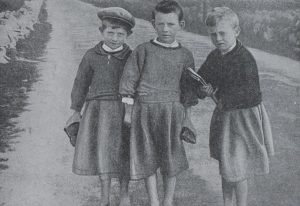A Fairy Tale for St. Patrick’s Day
Since having a daughter, I have learned more about fairies than I ever dreamed was possible. Fairies change the seasons, you know. They also paint butterfly wings and ladybugs and those little stripes on bumblebees. They build teapots out of acorns. They are born from the magic of a baby’s first laugh. How adorable!
At least, that’s what Disney would have you believe.
According to Irish folklore, where the fairy originated, fairies (faeries!) are not loveable, gentle, helpful little sprites. They are much, much darker.
Let’s begin at the beginning. Irish folklore has two origins of faeries. One; they are the original gods of Ireland, the ‘Tuatha De Dannan’, who were defeated in the final Gael conquest of Ireland. They weren’t banished, they were simply shrunken in size and forced to live in the wilderness. And two; when Christianity came to Ireland, faeries were explained as fallen angels. When Lucifer rebelled against God, some angels hesitated to pick a side. For this, they were cast from heaven and forced to remain wherever they fell. Some fell into mounds of the earth, some the woods and plains, some into the water. Some also fell into Hell and were taught by the devil to do evil to mankind. Both of these origins conclude with faeries who are jealous of humans, because faeries cannot die of old age – and will not die until “The Last Day” when they will simply wink out of existence, while humans will be given eternal life.
There are many, many stories of different types of faeries. For the purposes of keeping this blog entry short (and making sure it gets published before St. Patrick’s Day!), I offer you this little tidbit of information. The following is a screenshot from a book I was reading this weekend called “Irish Ghosts”, compiled by J. Aeneas Corcoran.

For those of you on mobile devices, it reads:
“The Taken – Fairies or Wild Spirits
The fairies, or wild spirits of the Irish countryside, were notorious for their snatching of human children. Boys especially were at risk. Many old photographs vouch for the fact that in the far west of Ireland, and well into the twentieth century, many boys even of ten or eleven were kept in dresses, to fool the fairies into supposing they were girls. One of W.B. Yeats’s most haunting poems is the fairies’ call to the mortal child: ‘Come away, o human child, To the waters and the wild, For the world’s more full of weeping than you can understand.’”
I thought it sounded a little far fetched, so I did a quick image search on the internet. Here are two photos I almost immediately found.

“Wicked fairies or “bad” people would run away with little boys but not with girls, so boys were dressed in petticoats to deceive them until they were of age to protect themselves.”

Rural Irish school boys wearing skirts to protect them from being kidnapped by Celtic fairies, 1936
Let that sink in for a minute. Can you imagine? Putting your son in a dress to keep him from being ABDUCTED BY FAERIES.
So, it appears that my youngest son is lucky his big sister loves to play pretty princess dress-up with him. Don’t worry, he’s completely willing. Big Sister can reach the cookie jar. He might be wearing a princess dress and sparkly glitter shoes, but he’s eating that cookie in style. And I don’t have to worry about faeries abducting my kids. Win!
- Emily